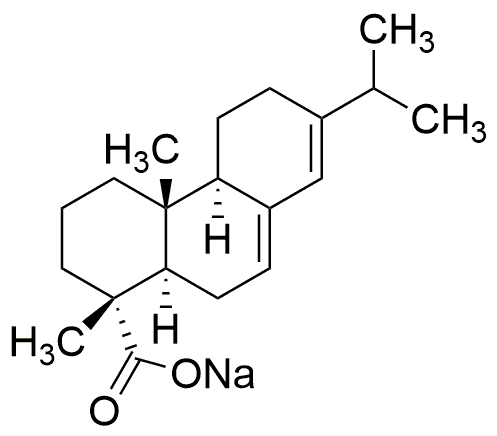Sodium abietate is widely utilized in research focused on:
- Cosmetic Formulations: This compound serves as an emulsifier and stabilizer in creams and lotions, enhancing texture and consistency while improving skin absorption.
- Pharmaceutical Applications: It is used in drug formulations to enhance solubility and bioavailability of active ingredients, making medications more effective.
- Adhesives and Sealants: Sodium abietate acts as a tackifier in adhesives, improving bonding strength and flexibility, which is beneficial in construction and manufacturing industries.
- Food Industry: It functions as a food additive, providing emulsifying properties that help in the stability of food products, particularly in sauces and dressings.
- Biodegradable Plastics: The compound is explored for use in developing eco-friendly plastics, contributing to sustainable practices in packaging and material science.
General Information
Properties
Safety and Regulations
Applications
Sodium abietate is widely utilized in research focused on:
- Cosmetic Formulations: This compound serves as an emulsifier and stabilizer in creams and lotions, enhancing texture and consistency while improving skin absorption.
- Pharmaceutical Applications: It is used in drug formulations to enhance solubility and bioavailability of active ingredients, making medications more effective.
- Adhesives and Sealants: Sodium abietate acts as a tackifier in adhesives, improving bonding strength and flexibility, which is beneficial in construction and manufacturing industries.
- Food Industry: It functions as a food additive, providing emulsifying properties that help in the stability of food products, particularly in sauces and dressings.
- Biodegradable Plastics: The compound is explored for use in developing eco-friendly plastics, contributing to sustainable practices in packaging and material science.
Documents
Safety Data Sheets (SDS)
The SDS provides comprehensive safety information on handling, storage, and disposal of the product.
Product Specification (PS)
The PS provides a comprehensive breakdown of the product’s properties, including chemical composition, physical state, purity, and storage requirements. It also details acceptable quality ranges and the product's intended applications.
Certificates of Analysis (COA)
Search for Certificates of Analysis (COA) by entering the products Lot Number. Lot and Batch Numbers can be found on a product’s label following the words ‘Lot’ or ‘Batch’.
*Catalog Number
*Lot Number
Certificates Of Origin (COO)
This COO confirms the country where the product was manufactured, and also details the materials and components used in it and whether it is derived from natural, synthetic, or other specific sources. This certificate may be required for customs, trade, and regulatory compliance.
*Catalog Number
*Lot Number
Safety Data Sheets (SDS)
The SDS provides comprehensive safety information on handling, storage, and disposal of the product.
DownloadProduct Specification (PS)
The PS provides a comprehensive breakdown of the product’s properties, including chemical composition, physical state, purity, and storage requirements. It also details acceptable quality ranges and the product's intended applications.
DownloadCertificates of Analysis (COA)
Search for Certificates of Analysis (COA) by entering the products Lot Number. Lot and Batch Numbers can be found on a product’s label following the words ‘Lot’ or ‘Batch’.
*Catalog Number
*Lot Number
Certificates Of Origin (COO)
This COO confirms the country where the product was manufactured, and also details the materials and components used in it and whether it is derived from natural, synthetic, or other specific sources. This certificate may be required for customs, trade, and regulatory compliance.


